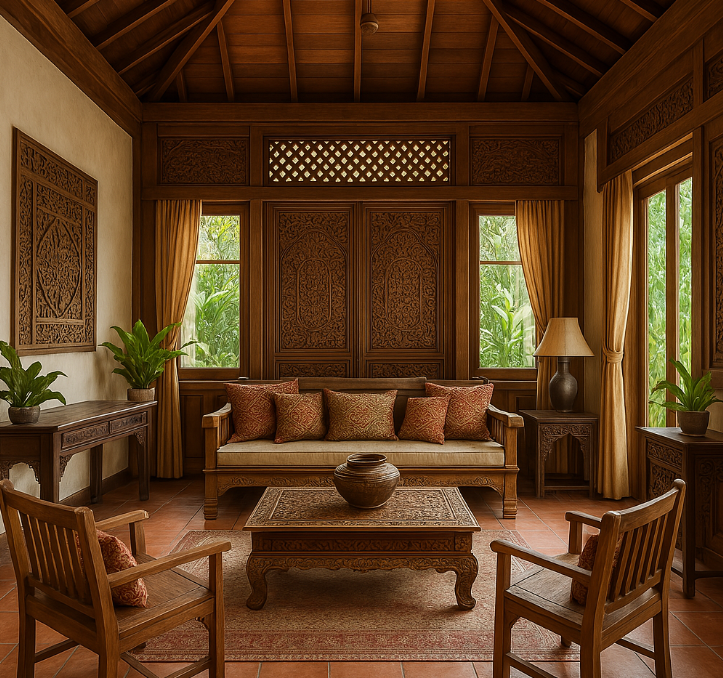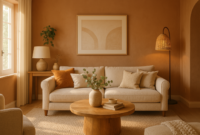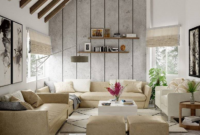The Beauty of Indonesian Style Home Room Design
Indonesia, an archipelago rich in cultural diversity and natural beauty, has long influenced the world with its distinct traditions, artistry, and architectural aesthetics. Among its many cultural exports, the Indonesian style of home room design stands out for its warmth, elegance, and harmonious blend of nature with craftsmanship. This design philosophy, deeply rooted in Indonesia’s ethnic diversity and tropical environment, is more than just a style—it is an experience that reflects a lifestyle grounded in tranquility, connection, and tradition.
The Origins and Influences of Indonesian Home Design
Indonesian home room design draws its essence from the varied cultures of over 17,000 islands. The aesthetic borrows elements from Javanese, Balinese, Sundanese, Dayak, and other ethnic traditions, each offering unique contributions to a shared design language.
The traditional Javanese “Joglo” house with its signature trapezoidal roof, the open layout of a Balinese villa surrounded by lush gardens, and the rustic charm of Batak architecture from North Sumatra are all part of the Indonesian home design lexicon. These influences emphasize sustainability, spirituality, and craftsmanship—each deeply embedded in the daily life and philosophy of Indonesians.
Key Elements of Indonesian Interior Design
1. Natural Materials
At the core of Indonesian design is the extensive use of natural materials. Teak wood, bamboo, rattan, and stone are prominently featured in both structural and decorative elements. These materials are chosen not only for their availability but for their durability and ability to age gracefully over time.
Furniture is often handmade by local artisans, showcasing traditional joinery techniques and intricate carvings. A teak wood coffee table or rattan armchair, for example, becomes a statement of cultural heritage, bridging functionality and art.
2. Open Layout and Airflow
One of the most distinctive characteristics of Indonesian homes is their openness. Traditional homes are designed to encourage air circulation, a necessity in the tropical climate. High ceilings, open windows, and indoor-outdoor transitions keep the space cool and ventilated, reducing the reliance on air conditioning.
In modern interpretations, glass sliding doors open to lush gardens or courtyards, continuing this legacy of fluid space and natural ventilation.
3. Connection with Nature
Indonesian style integrates nature into everyday life. Interior spaces often open to private gardens, koi ponds, or open-air bathrooms. Plants such as orchids, palms, and bamboo are incorporated into the design to create a sense of peace and serenity.
Water features, such as indoor fountains or reflecting pools, are also common, offering not just visual appeal but the calming sound of running water—a nod to the importance of harmony in both Balinese and Javanese philosophies.
4. Traditional Art and Textiles
Decorative elements in an Indonesian-style room are rarely mass-produced. Instead, homes are adorned with handwoven ikat textiles, batik prints, wayang (shadow puppets), masks, and sculptures. Each piece tells a story—of a village, a belief, or a myth passed down through generations.
Wall hangings, throw pillows, and table runners made of traditional cloth bring color and texture to the space, often featuring earthy reds, browns, deep blues, and golds.
5. Cultural Symbolism
Indonesian home design often incorporates spiritual or symbolic elements. In Bali, for instance, homes are built according to “Asta Kosala Kosali,” a traditional Hindu-based spatial rule similar to Feng Shui, which ensures balance and harmony in construction. Sacred spaces like small altars or shrines are commonly found in living areas or gardens, respecting the spiritual beliefs of the occupants.
Room-by-Room Breakdown of an Indonesian-Style Home
Living Room
The living room is the heart of the Indonesian home. It is usually spacious and open, with plenty of natural light streaming in through large windows or glass doors. The centerpiece is typically a low teak wood table surrounded by rattan or upholstered sofas adorned with batik-patterned cushions.

Decorative items might include large wooden sculptures, tribal masks, or a framed traditional painting. Houseplants or indoor trees bring in freshness, while soft lighting from woven pendant lamps creates a cozy ambiance during the evening.
Bedroom
A typical Indonesian bedroom combines comfort with subtle luxury. A canopy bed with a white mosquito net is both a practical and aesthetic choice. Bedding is simple, often white or earth-toned, accentuated with colorful woven throws or pillowcases.
Furniture remains minimal but elegant—nightstands and dressers crafted from solid wood, often with hand-carved details. Sliding doors may open to a balcony or garden, allowing natural light and a view of nature to greet you each morning.
Bathroom
In high-end Indonesian homes, bathrooms often blur the line between indoors and outdoors. An open-air concept is common, with stone walls, bamboo dividers, and plants integrated directly into the layout. Showers may be set against rock walls with rainwater-style showerheads, creating a natural spa-like experience.
Materials like polished concrete, lava stone, and wooden flooring lend an organic feel, while minimalist fixtures keep the space modern and functional.
Kitchen and Dining Area
Indonesian kitchens emphasize practicality, often separated into a “clean kitchen” for presentation and a “dirty kitchen” for actual cooking. However, in contemporary homes, these two spaces are sometimes merged.
Wooden cabinets, terracotta tiles, and copper or brass utensils lend a traditional charm. In the dining area, a long wooden dining table serves as a communal gathering spot. Overhead, a woven pendant lamp may hang, adding a touch of rustic elegance.
Meals are typically served family-style, encouraging sharing and togetherness, further reinforcing the Indonesian value of kebersamaan (togetherness).
Modern Interpretations and Global Appeal
While rooted in tradition, Indonesian style has successfully evolved into contemporary settings. Designers and architects often combine traditional elements with modern sensibilities to suit urban lifestyles. For example, a minimalist loft in Jakarta might feature exposed concrete walls, but soften the space with a reclaimed teak cabinet, traditional artwork, and tropical plants.
This fusion is not limited to Indonesia. Globally, designers draw inspiration from Indonesian aesthetics to create spaces that exude warmth, authenticity, and a connection to nature—qualities that resonate in a world increasingly seeking calm and mindfulness.
Eco-conscious building practices, such as using reclaimed wood or locally sourced materials, further contribute to the global appeal of Indonesian home design. Its focus on sustainability and artisan craft is in tune with current architectural and design trends.
Tips for Incorporating Indonesian Style into Your Home
Even if you don’t live in Southeast Asia, you can bring the spirit of Indonesian design into your home with a few thoughtful touches:
-
Use Natural Materials: Opt for furniture made from rattan, teak, or bamboo. Even small accents like a rattan tray or bamboo mirror can make a big difference.
-
Add Tropical Plants: Incorporate leafy greens like monstera, palms, or orchids to echo Indonesia’s lush landscapes.
-
Introduce Traditional Textiles: Use batik or ikat in cushion covers, table runners, or framed wall art.
-
Embrace Earth Tones: Stick to a palette of warm browns, muted greens, terracotta, and cream for a grounded, calming vibe.
-
Support Artisan Craftsmanship: Seek out handmade or fair-trade Indonesian goods, such as hand-carved statues or woven baskets.
Conclusion: A Timeless Elegance Rooted in Culture
The beauty of Indonesian-style home room design lies not just in its visual appeal, but in the stories it tells and the values it upholds. It is a design approach that celebrates craftsmanship, honors nature, and creates spaces that feel both timeless and alive.
Whether it’s the intricate woodwork of a Javanese doorway, the peaceful garden of a Balinese villa, or the rustic simplicity of a rattan chair, each element serves a purpose beyond aesthetics—it connects us to tradition, place, and the rhythm of natural life.
In a world often dominated by trends, the Indonesian style stands as a gentle reminder that true beauty comes from authenticity, balance, and harmony.


